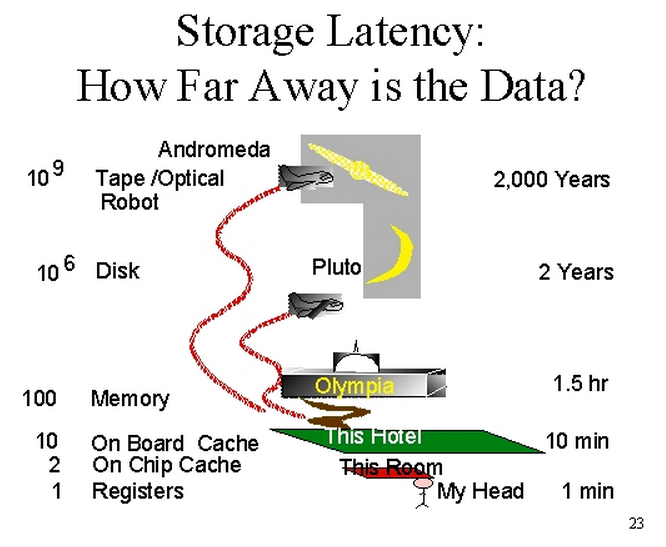We won't have to deal with most of the physical components of the computer when writing our programs, but we should understand about what the disk is and does.
The result of our programs isn't capable of storing any data yet- one of the most important features of any computer system. We need to be able to build a way to store things on our server, and manipulate them.
(You may have used localStorage in your project, but it's just a hack that works around the official spec of how to build a web application.)
The only official way that we've seen to store data is when you press Command-S on your script and HTML files. Your programs don't have the ability to save anything that the user does.
One of the big differences is that Node.js is designed to be event-driven and asynchronous. While earlier frameworks can only do one thing at a time, Node purposefully sends nearly everything to the background and keeps going.
Just like a click event is something that is designated to happen at another time, we will see that server side processing of a request follows a similar pattern- one where we actaully have no idea when or any control over when we can successfully send a response to the request.
Relative "distances" are actually quite far when in the context of executing a program. (In other words, this metaphor is to scale in the mathematical sense)
https://blog.codinghorror.com/the-infinite-space-between-words/
We will be using the jsonfile node package to write plain JSON text to our disk. This will come in handy later when we need to store info in our web applications.
Begin in a new directory
mkdir jsondisk
cd jsondisk
Make a node project
npm init
Add the library
npm install jsonfile
Add your js file
touch index.js
Edit your file with this text:
sublime index.js
const jsonfile = require('jsonfile');
const file = 'data.json'
jsonfile.readFile(file, (err, obj) => {
console.log(obj)
})
Run the file.
node index.js
Nothing will happen because we specified a file that doesn't exist.
Create the file.
touch data.json
Run the file.
node index.js
Nothing will happen because the file is empty.
Put something in the json file.
{
"bannana":"monkey",
"coconut":"sloth"
}
Note you don't need to assign it to a variable.
Run the file.
node index.js
const jsonfile = require('jsonfile');
const file = 'data.json'
const obj = {
"hello" : "banana",
"goodbye" : "banana"
};
jsonfile.writeFile(file, obj, (err) => {
console.log(err)
});
So far we can read all the contents of a file, and then write all the contents of a file.
In order to add something to the file, we need to read the content, then when we have all the data in the file assigned to a variable (obj in the example below), we can alter it, then write it back out.
const jsonfile = require('jsonfile');
const file = 'data.json'
jsonfile.readFile(file, (err, obj) => {
console.log(obj);
obj["helloworld"] = "monkey";
jsonfile.writeFile(file, obj, (err) => {
console.log(err)
});
});
- Follow the setup instructions above.
- Create the JSON file in sublime.
- Read the JSON file.
- Check it against the JSON text in the sublime file.
- Write to the json file.
- Check it against the JSON text in the sublime file.
- Write something new to the json file.
- Check it against the JSON text in the sublime file.
- Read and then write back out to the JSON file.
- Check it against the JSON text in the sublime file.
Take 2 command line arguments and write them as key and value into the JSON.
Ex: node index.js add bananaCount 3
Add each command the user does to a list in the JSON file. (Also keep the previous functionality)
Ex: node index.js addToList banana

